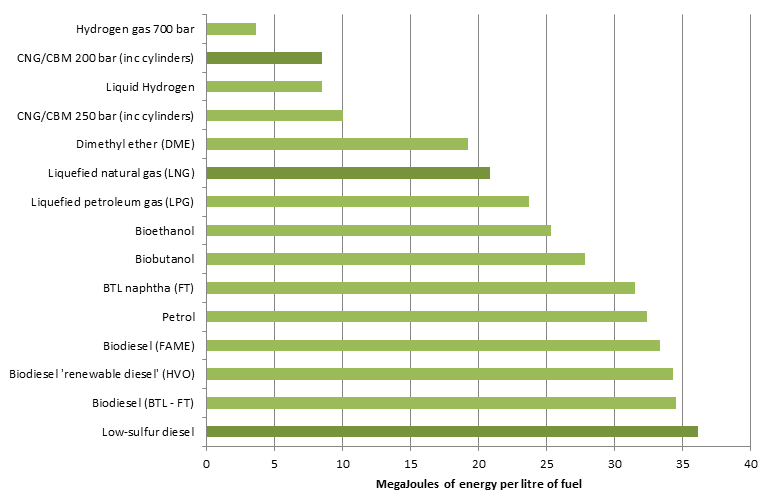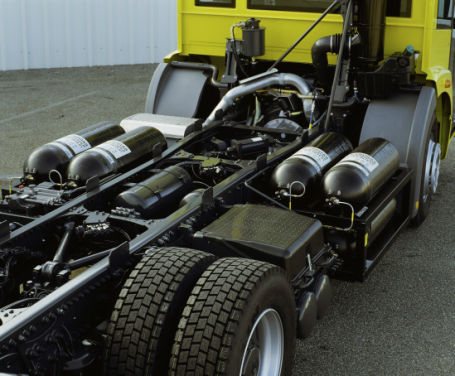[This post is based on part of a presentation I gave to the Global Biomethane Congress in Brussels this October. The full presentation is available here.]
There are lots of advantages to running trucks and buses on gas, compared to diesel. Gas is cheaper (half the duty of diesel), cleaner (no particulate emissions), and if you use biomethane, i.e. gas from waste, then you can get up to huge reductions in greenhouse gas emissions. Vehicles even run more quietly on gas.
There are downsides of course. The main one is the initial cost of switching, but that goes for any new technology. But, as with electric vehicles, another big issue is how much fuel you can get in the vehicle, and therefore its range.
The problem is that gas is, of course, a lot less dense than diesel. In fact, most other fuels have a lower energy density than diesel, as illustrated by the chart below. (All data from the Oak Ridge National Laboratory in the US.)
The easiest thing to do with your gas is compress it, and for vehicles in Europe this usually means compressing to 200 bar. As you can see from the bar chart above, looking at the bars for CNG (Compressed Natural Gas), that means your fuel will take up much more space than diesel. The gas tanks are heavy too, so you may lose some of your payload. In practice, this usually means you can’t have as much fuel on the vehicle, and you have to accept a cut in range.
But is the drop in range really that much of a problem? I thought I’d do a few quick calculations to figure this out.
The typical set up for putting gas cylinders on mid-size trucks, and refuse collection vehicles, is in two banks of four 80 litre tanks, like in the picture below. This can of course be modified if requested, and buses often have a different arrangement with gas cylinders on the roof, but it seems that 640 litres of gas (2 x 4 x 80) is fairly standard. So how far will this get you?
Well, 640 litres of gas at 200 bar pressure has the same energy as about 150 litres of diesel. However, diesel is used in a compression ignition engine, whereas gas needs to be burned in a spark ignition engine, and compression ignition is about 25% more efficient than spark ignition. So, our 640 litres of gas will actually get us as far as about 120 litres of diesel.
Last year I wrote the final report on a trial of a gas refuse collection vehicle (RCV) by Leeds City Council. Their RCVs get about 3.3 mpg, which means that 120 litres of diesel would give a range of 86 miles. Urban RCV routes are about 50 miles in Leeds, with the longest routes into the surrounding area getting up to around 100 miles. So, a range of 86 miles shouldn’t present a barrier to cities all over the country running these fuel thirsty vehicles on gas.
What about buses? Well, a conservative estimate would suggest a bus getting 8 mpg, in which case 120 litres of diesel (equivalent) would give a range of 210 miles – which is plenty for an urban bus. Hardly surprising then, that cities all over the world are switching their buses to run on gas, mainly driven by the desire to improve air quality, although financial savings are also welcome.
Are trucks a different story, hauling up and down the motorway all day? Well, yes and no. For big articulated 44t trucks there currently isn’t really a 100% gas option (the reasons for which I’ll cover in another post soon). However, for the smaller, rigid trucks in the 7.5 – 26t range, gas is an option. An 18t truck, for example, might get around 12 mpg, so 120 litres of diesel would give a range a little over 300 miles. Department for Transport figures show that vehicles of this type make very few trips over this range.
There is no doubt that one of the things fleet operators worry about, when considering gas, is the drop in range of their vehicles. But as with electric cars, we’ve become so used to the incredible energy density of diesel and petrol, and the huge range it gives our vehicles, that it can be hard to swallow a reduction – even if the reality is that we don’t really need it most of the time.
[For those few applications where we do need greater range, gas vehicles can use liquefied gas, which you may have noticed from the graph has a much higher energy density. And indeed one of the big debates in the gas vehicle community is on the relative merits of compressing vs liquefying gas. But that’s a story for another post.]


